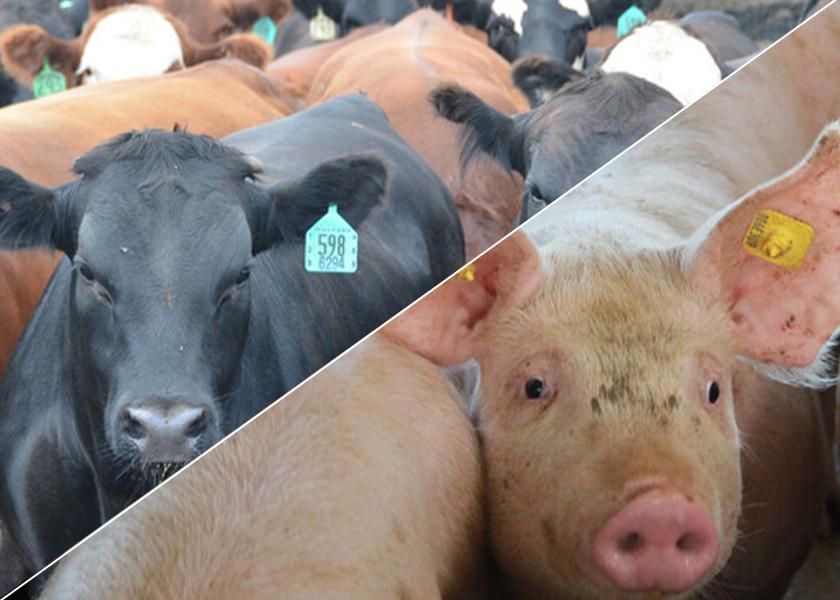Livestock Analysis | January 22, 2022

Price action: April lean hog futures surged $2.075 to $91.35, the contract’s highest close since $91.825 on June 10. Nearby February futures rose 70 cents to $82.30.
Fundamental analysis: Hog futures extended a steep rally, closing higher for the fourth day in the past five, on signs of strengthening cash fundamentals and retail demand. Pork cutout values rose $6.29 early today to $93.50, led by a gain of nearly $30 in primal hams. Movement by midday was nearly 231 loads. Cutout values have had a tendency to jump higher in the morning before ending the day lower, but the market’s bounce off December lows suggests retail demand improved while supplies tightened amid Covid-related slaughter plant slowdowns.
Bullish enthusiasm in nearby February futures was likely diminished by the slight 7-cent rise, to $76.85, in the preliminary quote for the next CME lean hog index. That places February futures at a $5.45 premium to the cash equivalent price with less than a month until its expiration (and cash-settlement against the index).
The prospect of much stronger prices powered strong gains in spring and summer futures contracts, including May and June. That likely reflects anticipation of seasonal strength as well as annual hog supply shortfalls diminishing from winter levels 6.0% below year-ago levels to rates 4.0% under spring-summer 2021 rates. We suspect rising inflationary expectations also played a role in deferred futures’ gains, especially with the energy, precious metal and grain markets posting strong gains. Rebounding cattle and wholesale beef prices probably encouraged bulls in the hog market as well.
Technical analysis: This week’s gains have given bulls a clear technical advantage, especially with the advance pushing the February futures above short- to intermediate-term moving averages. The 20-, 40- and 10- day moving averages now mark support at $81.35, $80.84 and $80.26, respectively. A drop below those levels would have bears targeting last week’s low at $77.05. Bulls now face resistance at the Jan. 6 high of $84.05, then at the Dec. 27 high of $84.65.
What to do: Get current with feed advice. We are targeting a drop to the $385 area (50% retracement of the November-to-January rally) to further extend coverage. You remain hand-to-mouth on corn-for-feed needs. Our target for extending corn coverage would be a drop to the $5.75 area.
Hedgers: Carry all risk in the cash market for now.
Feed needs: You have all soymeal needs covered in the cash market through the end of January. You remain hand-to-mouth on corn-for-feed needs.
Price action: April live cattle rose $1.50 to $143.35, the highest closing price since $144.20 on Jan. 3. March feeder cattle rose 20 cents to $165.625.
Fundamental analysis: Live cattle futures gained support from general strength in the commodity sector and heightened inflation concerns, as well as from rising wholesale beef prices that suggest improved retailer demand. Choice cutout value early today rose another $1.56 to $291.05, the highest daily average since early November, while Select grade rose $1.32. Movement was decent at midday, at 78 loads.
This week’s negotiated cash cattle trade has occurred mostly at $137.00 live and $217.00 to $220.00 in the dressed market, generally steady to slightly firmer compared with last week. Cash sources said some of today’s strength was tied to expectations slaughter levels are returning to “normal,” after meatpackers struggled with Covid-related worker absenteeism. Live steer carcass weights reached 928 pounds per head during the last week of December, suggesting a building backlog of animals at feedlots that may give packers the upper hand in price negotiations in the near term.
Technical analysis: Live cattle bulls have a firm near-term technical advantage as prices are not far below the contract high scored in late December. Bulls' next upside objective is closing April futures above solid resistance at the contract high of $145.85. The next downside objective for bears is closing prices below solid support at the December low of $139.925. First resistance is seen at the November high of $144.60, then at $145.00. First support is seen at $142.50, then at this week’s low of $141.425.
Feeder cattle futures bulls have the overall near-term technical advantage, but trading has turned choppy and sideways. The next upside objective for the bulls is closing March futures above resistance at the contract high of $171.575. The next downside objective for bears is closing prices below solid support at the December low of $159.90. First resistance is seen at today’s high of $166.925, then at $167.825. First support is seen at the January low of $164.55, then at $163.00.
What to do: Get current with feed advice. We are targeting a drop to the $385 area (50% retracement of the November-to-January rally) to further extend coverage. You remain hand-to-mouth on corn-for-feed needs. Our target for extending corn coverage would be a drop to the $5.75 area.
Hedgers: Carry all risk in the cash market for now.
Feed needs: You have all soymeal needs covered in the cash market through the end of January. You remain hand-to-mouth on corn-for-feed needs.






